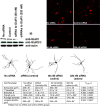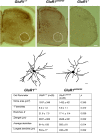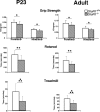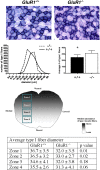Role of GluR1 in activity-dependent motor system development
- PMID: 18829953
- PMCID: PMC3844744
- DOI: 10.1523/JNEUROSCI.0880-08.2008
Role of GluR1 in activity-dependent motor system development
Abstract
Activity-dependent specification of neuronal architecture during early postnatal life is essential for refining the precision of communication between neurons. In the spinal cord under normal circumstances, the AMPA receptor subunit GluR1 is expressed at high levels by motor neurons and surrounding interneurons during this critical developmental period, although the role it plays in circuit formation and locomotor behavior is unknown. Here, we show that GluR1 promotes dendrite growth in a non-cell-autonomous manner in vitro and in vivo. The mal-development of motor neuron dendrites is associated with changes in the pattern of interneuronal connectivity within the segmental spinal cord and defects in strength and endurance. Transgenic expression of GluR1 in adult motor neurons leads to dendrite remodeling and supernormal locomotor function. GluR1 expression by neurons within the segmental spinal cord plays an essential role in formation of the neural network that underlies normal motor behavior.
Figures









Similar articles
-
Bi-directional control of motor neuron dendrite remodeling by the calcium permeability of AMPA receptors.Mol Cell Neurosci. 2006 Jul;32(3):299-314. doi: 10.1016/j.mcn.2006.04.008. Epub 2006 Jun 21. Mol Cell Neurosci. 2006. PMID: 16790357
-
Differential regulation of dendrite complexity by AMPA receptor subunits GluR1 and GluR2 in motor neurons.Dev Neurobiol. 2008 Feb 1;68(2):247-64. doi: 10.1002/dneu.20590. Dev Neurobiol. 2008. PMID: 18000827
-
In situ hybridization analysis of AMPA receptor subunit gene expression in the developing rat spinal cord.Neuroscience. 1995 Aug;67(4):909-20. doi: 10.1016/0306-4522(95)00094-y. Neuroscience. 1995. PMID: 7675213
-
GluA1 promotes the activity-dependent development of motor circuitry in the developing segmental spinal cord.Ann N Y Acad Sci. 2013 Mar;1279:54-9. doi: 10.1111/nyas.12053. Ann N Y Acad Sci. 2013. PMID: 23531002 Free PMC article. Review.
-
Neuronal correlates of the dominant role of GABAergic transmission in the developing mouse locomotor circuitry.Ann N Y Acad Sci. 2013 Mar;1279:43-53. doi: 10.1111/nyas.12064. Ann N Y Acad Sci. 2013. PMID: 23531001 Review.
Cited by
-
Pentraxin 3 regulates synaptic function by inducing AMPA receptor clustering via ECM remodeling and β1-integrin.EMBO J. 2019 Jan 3;38(1):e99529. doi: 10.15252/embj.201899529. Epub 2018 Nov 5. EMBO J. 2019. PMID: 30396995 Free PMC article.
-
The molecular basis of experience-dependent motor system development.Adv Exp Med Biol. 2013;782:23-38. doi: 10.1007/978-1-4614-5465-6_2. Adv Exp Med Biol. 2013. PMID: 23296479 Free PMC article.
-
Electrical activity as a developmental regulator in the formation of spinal cord circuits.Curr Opin Neurobiol. 2012 Aug;22(4):624-30. doi: 10.1016/j.conb.2012.02.004. Epub 2012 Feb 25. Curr Opin Neurobiol. 2012. PMID: 22370142 Free PMC article. Review.
-
Epilepsy-associated gene Nedd4-2 mediates neuronal activity and seizure susceptibility through AMPA receptors.PLoS Genet. 2017 Feb 17;13(2):e1006634. doi: 10.1371/journal.pgen.1006634. eCollection 2017 Feb. PLoS Genet. 2017. PMID: 28212375 Free PMC article.
-
Emerging Roles of Filopodia and Dendritic Spines in Motoneuron Plasticity during Development and Disease.Neural Plast. 2016;2016:3423267. doi: 10.1155/2016/3423267. Epub 2015 Dec 30. Neural Plast. 2016. PMID: 26843990 Free PMC article. Review.
References
-
- Altman J, Sudarshan K. Postnatal development of locomotion in the laboratory rat. Animal Behav. 1975;23:896–920. - PubMed
-
- Bannerman DM, Deacon RM, Brady S, Bruce A, Sprengel R, Seeburg PH, Rawlins JN. A comparison of GluR-A-deficient and wild-type mice on a test battery assessing sensorimotor, affective, and cognitive behaviors. Behav Neurosci. 2004;118:643–647. - PubMed
-
- Bar-Peled O, O'Brien RJ, Morrison JH, Rothstein JD. Cultured motor neurons possess calcium-permeable AMPA/kainate receptors. Neuroreport. 1999;10:855–859. - PubMed
-
- Blackstone CD, Levey AI, Martin LJ, Price DL, Huganir RL. Immunological detection of glutamate receptor subtypes in human central nervous system. Ann Neurol. 1992;31:680–683. - PubMed
Publication types
MeSH terms
Substances
Grants and funding
LinkOut - more resources
Full Text Sources
Other Literature Sources
Molecular Biology Databases
Research Materials
